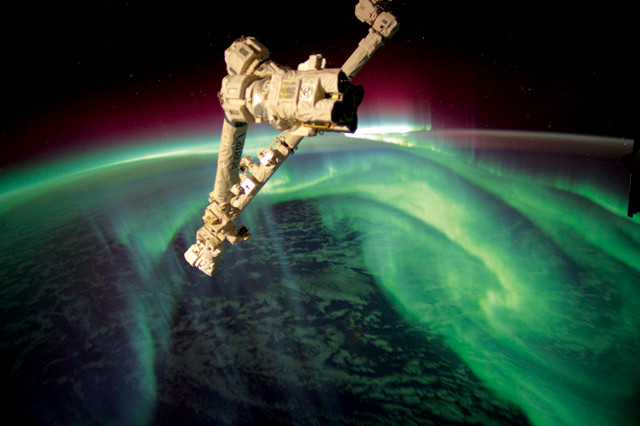
by Julia Rosen Monday, June 8, 2015

Space weather results from variations in solar activity, and causes phenomena like aurorae. Credit: Joe Acaba, NASA.
F5VIH. KM3T. PY1NB. These strings of letters and numbers aren’t license plate numbers but call signs. They belong to a handful of Ham radio operators, just three of the more than 2 million amateur enthusiasts whose chatter fills the global airwaves day and night. Now, research suggests these communications may represent a vast trove of data that could help scientists study and monitor space weather.
Space weather encompasses the phenomena that occur in the ionosphere — the outermost layers of Earth’s atmosphere — arising from the sun’s activity and its interactions with the planet’s magnetic field. Disturbances, like the geomagnetic storms that light up aurorae, can disrupt communication systems and GPS networks, while strong events like solar flares can threaten spacecraft, satellites and even terrestrial power grids.
Space weather also affects Ham radio signals. “Ordinarily, radio waves — like light — travel in straight lines, but they are affected by the medium in which they propagate,” says Joe Taylor, a Nobel Prize-winning astrophysicist at Princeton University and a lifelong Ham operator who goes by the call sign K1JT and was not involved with the new study. “If they are moving through the atmosphere, they can be refracted or reflected in the same kinds of ways that ordinary light can.”
In fact, the short-wave frequencies used by Hams, which range from 3 to 30 megahertz, bend so much that they actually come back to Earth — that’s how a user in the U.S. can say hello to a friend in Australia. But just how much these radio waves bend and how far they propagate depends on their frequency and the amount of ionization in the upper atmosphere, which in turn depends on space weather.
Generally speaking, more ionization enables better signal propagation, but during extreme events, like when a solar flare temporarily blew away the ionosphere on May 13, 2013, communication can be cut off entirely.
One of NASA’s Geostationary Operational Environment Satellites (GOES) documented this event, but Nathaniel Frissell, a space scientist at Virginia Tech and lead author of the new study, wondered if he could also detect the flare in archives of Ham radio transmissions. So, he looked at data from the Reverse Beacon Network, a grassroots organization that catalogs all radio transmissions received at a web of listening stations scattered around the world. (The call signs listed at the beginning of this article belong to some of the Network’s founders, a group that also includes N4ZR, W3OA and VE3NEA.)
Frissell found that although radio propagation conditions were strong before the solar flare, permitting communication between Europe and South America, for example, the number of calls dropped precipitously right after it struck. Frissell, also a Ham enthusiast since his teens, says this illustrates how amateur radio networks can be used to monitor space weather and augment existing scientific observation networks.
Formal networks, such as the National Science Foundation-sponsored SuperDARN program, provide a lot of useful data, which Frissell also studies, but they can’t monitor everything. “Ideally, you’d have a sensor in every single part of the sky from the ground all the way out into space,” Frissell says. Of course, that’s not possible, and Frissell says Ham communications might help fill gaps and provide additional data, similar to what private meteorological stations do for the National Weather Service. “Similar, but for space,” he says.
This approach isn’t all that different from the one used by Anthea Coster of MIT’s Haystack Observatory, who studies space weather using signals sent and received by scientific GPS stations. Coster says Frissell’s work demonstrates that Ham radios can “add information to the global picture of what’s happening,” primarily because “different frequencies are sensitive to different irregularities in the ionosphere.”
Coster also praised the choice of the Reverse Beacon Network because it is passive and autonomous, and thus, doesn’t need an operator to record data. There are several other Ham networks in existence, all designed to provide information on the state of the ionosphere for radio users, including one established by Taylor, called WSPRnet. One day, Frissell hopes to integrate them all into a single database.
So far, Ham communications only provide qualitative information about space weather events like solar flares. Moving beyond this presents a formidable challenge because the call data aren’t produced systematically or explicitly for scientific purposes. For now, Frissell hopes the new study, published in the journal Space Weather, will highlight the scientific utility of Ham communication data. “The space physics community may be less aware of the amateur radio community, and the types of contributions it can make and already is making,” he says.
These kinds of contributions, along with emergency communication, education and promotion of international goodwill, are why governments have reserved frequencies for Ham users in the first place. This is just one more way Hams can help, Frissell says: “Anyone at home can go set one of these receivers up and contribute back into science.”
© 2008-2021. All rights reserved. Any copying, redistribution or retransmission of any of the contents of this service without the expressed written permission of the American Geosciences Institute is expressly prohibited. Click here for all copyright requests.